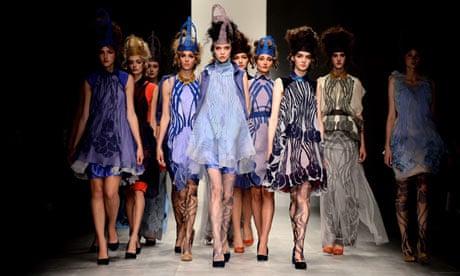Ten years ago, a definition of sustainable fashion by a high street shopper might have included the words hemp, natural and definitely organic. I too would probably have said something similar. But after immersing myself in the world of sustainability and working with eco activist Suzy Amis Cameron (wife of James Cameron) and the Cradle to Cradle Products Innovation Institute, I have come to appreciate that it can be inspiring, commercially viable, and bang on-trend.
The transformation in my thinking was also influenced by reading Sass Brown's Eco Fashion, and Safia Minney's Naked Fashion.
One year into my role as global campaign director of Red Carpet Green Dress, a sustainable dress design contest founded by Cameron in 2009, I realise that there is the potential to lead a revolution in the way the fashion industry is run.
For that to happen, there needs to be a sense of excitement about the innovative potential of the sector among the world's top designers. This is because their approval is essential if greater sustainability is to reach the high street.
That is now starting to happen. Just look at Stella McCartney's innovative waterless T-shirt, coloured using pressurised C02 or consider the success of the rocking vintage parties held during Fashion's Night Out , a global initiative sponsored by Vogue and the Council of Federations for the Designers of America (CFDA).
H&M's colourful Conscious Collection is making its presence on the red carpet, worn by the likes of Viola Davis and Michelle Williams. Lady Gaga recently demonstrated her support for Vivienne Westwood's Climate Change manifesto by wearing the campaign's T-shirt.
In fact there are scores of eco designers skillfully combining design and sustainability.
Take a look at vegan shoe range Mink, or ready to wear clothing by People Tree, a brand Harry Potter star Emma Watson designed an entire range for, or even evening and bridal gown designer Lindee Daniel who uses organic vegetarian silks and cottons.
But we need to go one step further for sustainable fashion to enter the mainstream and that is to drop the idea altogether of being worthy and instead concentrate on innovation.
The simple truth is that image is all-important in the world of fashion. Ethical companies must recognise that and swim with the tide or risk being pulled under by the weight of the message. What we have learnt beyond doubt is that leveraging the guilt factor alone will not work. Design matters.
Companies ignore style at their peril. The success of outdoor clothing brand Patagonia is primarily because of the design and performance of its products. It's mission statement – "to cause no unnecessary harm, use business to inspire and implement solutions to the environmental crisis" – is secondary.
Imagine you are in your favourite clothing store and spot an item you want to buy.
It's almost certainly because you love the look of it, the colour, the style. While eco conscious shoppers might be driven by more ethical considerations when making purchases, the same does not necessarily apply to the average shopper. Whether an item is made from conventional cotton, manufactured in a dimly-lit cramped factory in Bangladesh or coloured with potentially harmful synthetic dyes is simply not a crucial factor at the point of sale.
Even fewer people would look at the label to see whether it needed to be washed at an energy guzzling 80 degrees or worry about whether it will end up in a landfill after just a few wears.
Then there is the question of whether consumers are willing to pay a premium for a well-designed and sustainable fashion piece? Most general consumer research shows that only a small percentage are prepared to spend extra to buy organic or fair-trade products in a supermarket.
A specialist survey by Philippa Marsh showed that this is replicated in the fashion world.
While many liked the idea of an eco-label, they would pay no more than a 10% premium for it. However, when asked what extra they would pay for tailored clothing, the figure shot up to 25%.
So perhaps its time to drop the word 'sustainable' altogether. Sony and Levi's Fashion Futures project developed scenarios for 2025 based around issues such as water and material scarcity and climate change. Those who took part came up with design-led ideas such as clothing which helps to self-regulate body temperature and which used less water in production. These were seen as exciting ideas that did not need to be typecast as 'eco' or 'green'.
Making headway in the fashion industry could have important knock-on effects. Not only is the global fashion industry huge in its own right but it has the ability to do what organic and fair-trade vegetables never could, and that is to make sustainability cool.
Samata Angel is global campaign director at the Red Carpet Green Dress Competition.
This content is brought to you by Guardian Professional. Become a GSB member to get more stories like this direct to your inbox

Comments (…)
Sign in or create your Guardian account to join the discussion